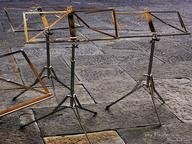Quiz Answer Key and Fun Facts
1. We'll start with two questions on the caprices themselves. Paganini's Caprices were written for which solo stringed instrument, on which Paganini himself was a virtuoso?
2. Although the most famous of Paganini's caprices is the last caprice in A minor, it was just one of many. How many caprices total were in his collection?
3. This composer was one of the first to base new material on the caprices, modeling 6 etudes after caprices other than the 24th. Paganini also makes an appearance in his "Carnaval" for piano, which was edited by his wife Clara.
4. Another set of piano works inspired by Paganini's Caprices was this composer's "Six Grande Etudes de Paganini", a revised version of one of several collections of "Transcendental Etudes" he wrote. The last of these Etudes is a theme and variations on the ubiquitous 24th caprice, but the third ("La Campanella" or "The Bells") may be more famous.
5. We complete the trifecta of Paganini for solo piano with this composer's 1862-1863 "Variations of a Theme by Paganini". The work is similar in style to his "Handel" and "Haydn" Variations, but rather different from his "Wiegenlied"
6. Paganini's Caprice continued to be a popular source for material throughout the 20th century. Which composer's 1934 "Rhapsody on a theme of Paganini" is often referred to as his "fifth piano concerto"?
7. "Rhapsody on a Theme of Paganini" features a second recurrent melody based on a 13th century plainsong chant written by Thomas of Celano. What is this text most commonly heard in Requiem masses?
8. Even World War II could not stop the onslaught of Paganini Caprices. When the Germans banned public concerts in Poland, which composer responded by composing a piece based on Paganini's Caprice that could be played in sidewalk cafes?
9. Meanwhile, in America, a jazzed-up version of the Caprice was arranged and performed in 1941 by this clarinetist and his band. He is perhaps best known for "Sing, Sing, Sing".
10. We finish with a decidedly modern set of variations on the theme. Andrew Lloyd Webber composed a 1978 set of variations on the 24th caprice for his brother Julian, a leading player of which instrument?
Source: Author
kevinatilusa
This quiz was reviewed by FunTrivia editor
bullymom before going online.
Any errors found in FunTrivia content are routinely corrected through our feedback system.

